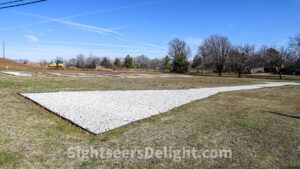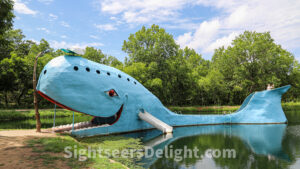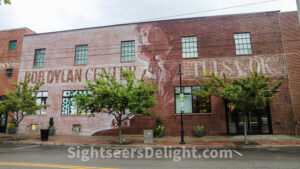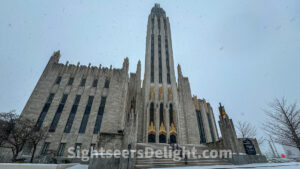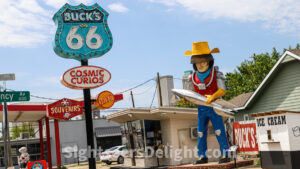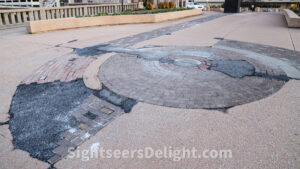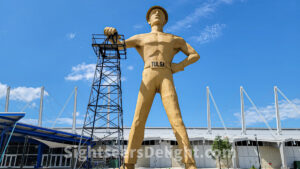74106
Hugh Davis built the Blue Whale of Catoosa, a waterfront structure, in the early 1970s as an anniversary gift to his wife, Zelta, a collector of whale figurines. Since then, the whale has become one of the most recognizable attractions along Route 66. The pond surrounding the whale was initially fed by a spring and intended only for family use. However, it was later a popular swimming spot for locals and passersby, though today, swimming is prohibited. The Davis family closed the landmark to the public in 1988, but it has since been restored and re-opened.
74015
The Bob Dylan Center is located in Tulsa’s burgeoning arts district, just steps from the city’s Woody Guthrie Center. The Bob Dylan Center features cutting-edge and immersive technology in a multimedia environment designed to impress visitors new to Dylan and long-time fans and aficionados. Visitors can listen to rare recordings, watch rarely seen videos and view one-of-a-kind memorabilia ad artifacts that tell the story of “the poet laureate of rock and roll.” The Bob Dylan Center and the Woody Guthrie Center operate under the auspices of the American Song Archives, a project of the George Kaiser Family Foundation. The foundation acquired Dylan’s archives in 2016 and Guthrie’s in 2010.
74103
Boston Avenue United Methodist Church is a historically significant church in downtown Tulsa, Oklahoma. Established in 1893, our congregation comprises more than 7,500 members from various backgrounds. The church building was built in 1929 and is recognized as one of the most exceptional examples of Art Deco architecture for ecclesiastical purposes in the United States. It has been listed on the National Register of Historic Places and designated a National Historic Landmark.
74119
The Bristow Train Depot and Museum is located in the historical Bristow train depot, constructed in 1923. Bristow grew up along a railroad running between Sapulpa and Oklahoma City. The museum features information about the town’s history and the people who shaped it. A former Atchison, Topeka & Santa Fe Railway caboose, built in 1929 and rebuilt in 1969, is on display next to the museum. It bears the paint scheme of the St. Louis–San Francisco Railway (the “Frisco”).
74010
Buck Atom’s Cosmic Curios is a souvenir shop celebrating Route 66. Visitors often visit the shop, housed in a renovated 1950s PEMCO gas station, for a chance to see Buck Atom, a 21-foot-tall space cowboy-themed “muffler man.” Buck Atom debuted in Tulsa in 2019.
74120
The Center of the Universe is a unique concrete circle in Tulsa with an acoustic anomaly. The circle is a little over eight feet in diameter, and any noise inside it echoes loudly. However, only those inside the circle can hear the echo. Surprisingly, these loud sounds cannot be heard from outside the perimeter of the brick structure. Visitors can access downtown Tulsa’s Center of the Universe through a brick path leading visitors from the Boston Avenue pedestrian overpass.
74103
Cyrus Avery Centennial Plaza is named in honor of the “Father of Route 66.” Avery, a Pennsylvania native, created the route while serving on a federal board tasked with creating the Federal Highway System. He pushed for establishing the U.S. Highway 66 Association to pave and promote the highway. n late 2012, artist Robert Summers unveiled a sculpture titled “East Meets West.” The detailed 135 percent-scale bronze depicts Avery stopping his Ford on the 11th Street Bridge as the vehicle startled a pair of horses pulling a wagon loaded with oil barrels.
74127
The Golden Driller is a 75-foot-tall statue of an oil worker and is said to be the sixth-tallest statue in the United States. The steel frame structure is covered with concrete and plaster and weighs 43,500 pounds. The Mid-Continent Supply Company of Fort Worth built the initial version in 1952 for the International Petroleum Exposition, and it re-appeared again for the 1959 show. While it was a temporary feature, the company donated the statue to the Tulsa County Fairgrounds Trust Authority, which had it redesigned and permanently installed in front of the Tulsa Expo Center for the 1966 International Petroleum Exposition. The statue rests his right hand on an oil derrick that had been moved from a depleted oil field in Seminole, Oklahoma. The statue has stood in front of the Tulsa Expo Center since 1966.
74114
Highland Cemetery was established in 1908 and is the final resting place of many early Okemah, Oklahoma, leaders. It also contains the family burial plot of the family of legendary folk singer Woody Guthrie. Although he is not buried here, a cenotaph is located in Highland Cemetery in his honor. Guthrie’s mother, Nora Belle Sherman Guthrie, and father, Charley Guthrie, are buried here, as is his sister, Clara Edna Guthrie, brother, Lee Roy Guthrie, and one of his sons, Bill Roger Guthrie.
74859

